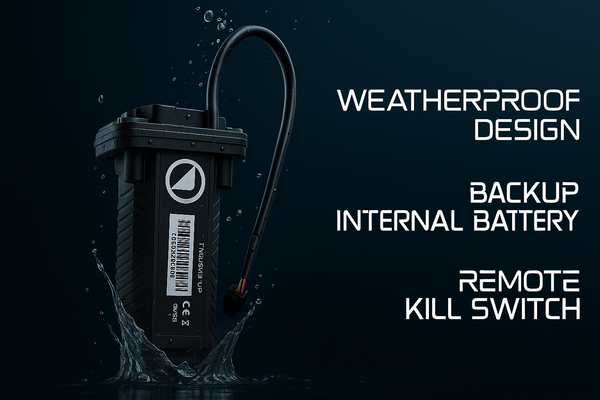AI‑Powered Notifications & Data Analysis: Transforming Fleet Insights into Actionable Intelligence
Turn telematics into action with FleetBold’s AI‑Powered Notifications & Data Analysis, delivering real‑time battery, safety, and utilization alerts for Turo hosts and rental fleets.

Managing a modern rental fleet demands more than raw telematics data—it requires intelligent, contextual alerts that drive proactive decisions. FleetBold’s AI‑Powered Notifications & Data Analysis continuously ingests vehicle telemetry, booking metadata, and optional third‑party feeds (weather, traffic) to detect critical events and deliver real‑time notifications. From battery‑health warnings and predictive maintenance to geofence breaches and harsh‑driving alerts, this feature turns data into a command‑center dashboard, enabling hosts and fleet managers to anticipate issues, optimize utilization, and safeguard their bottom line.
Data Ingestion & Normalization
FleetBold’s data ingestion layer captures a continuous stream of telematics directly from each vehicle as well as booking details and external data sources. GPS coordinates, vehicle speed, acceleration/deceleration metrics, state of charge or fuel level, charging session logs, and CAN‑bus diagnostics are polled at high frequency—often sub‑second intervals—through a proprietary telematics connector. Simultaneously, reservation information (start/end times, mileage allowances, renter profiles) synchronizes via secure Gmail‑based links for Turo or through private CRM integrations. Optional data feeds, such as local weather forecasts and live traffic congestion maps, augment this stream, providing critical context. All inputs funnel into a normalization process that standardizes formats, timestamps, and identifiers (VINs), creating a unified event schema ready for analysis.
Feature Extraction & Real‑Time Metrics
Once normalized, the raw data travels through a feature‑extraction pipeline that computes rolling aggregates and derived metrics. Key features include:
- Battery State Trajectory: Hourly change in state of charge, number of deep‑cycle events, and cumulative charge cycles.
- Vehicle Health Indicators: Frequency of charging failures, cell‑imbalance alerts, and temperature excursions beyond safe thresholds.
- Driving Behavior Metrics: Count of harsh acceleration/braking events, average speed per segment, and idle time ratio.
- Location Patterns: Geofence crossings, dwell times at pickup/drop‑off zones, and clustering of GPS points.
- Operational Utilization: Active versus idle hours, trip durations, and average daily mileage.
These features update in near real time, ensuring that downstream analytics engines operate on fresh, accurate data. The pipeline is horizontally scalable, leveraging stream‑processing frameworks that can handle thousands of vehicles concurrently without lag.
Machine‑Learning Inference & Alert Generation
FleetBold employs a suite of machine‑learning models to interpret the extracted features:
- Anomaly Detection Models identify outliers in battery performance or drive behavior—such as a sudden drop in charging efficiency that may indicate an emerging hardware fault.
- Classification Models predict event types like flatbed tow operations (characterized by sustained speed with zero wheel rotations) or unauthorized commercial use (detected through frequent short‑hop trips in delivery zones).
- Predictive Maintenance Models estimate component failure risk based on cumulative usage patterns and historical failure data, allowing scheduling of service before breakdowns occur.
When a model’s output crosses a configurable confidence threshold, an alert is instantiated. Each alert encapsulates critical context—event type, VIN, precise timestamp, GPS location, and a confidence score—so hosts know exactly what happened, where, and how urgently they must respond.
Notification Delivery & Routing
Alerts are routed through multiple channels according to severity and operator preferences:
- Dashboard Feed: High‑volume, medium‑priority alerts populate an in‑app feed where fleet managers can filter by vehicle, event type, or time window.
- Mobile Push & SMS: Urgent notifications—battery overheating, geofence breach, or predicted critical failure—dispatch immediately to on‑call personnel.
- Webhook Integrations: For fully automated workflows, alerts post JSON payloads to preconfigured endpoints, triggering actions like opening maintenance tickets in enterprise systems or updating CRM records.
Delivery logic respects rate‑limits and groups related alerts to avoid notification fatigue. For instance, multiple harsh‑braking events within a short span might consolidate into a single “High‑Risk Driving” alert rather than separate notifications.
Technical Architecture
FleetBold’s AI‑Powered Notifications & Data Analysis feature sits on a microservices architecture designed for resilience and scale:
- Ingestion Service: Powered by Kafka (or equivalent), this service handles high‑throughput telematics and booking streams, ensuring ordering guarantees and fault tolerance.
- Feature Extraction Service: Stateless workers consume normalized events, compute rolling metrics, and update stateful stores for each vehicle.
- Model Serving Layer: Hosted on TensorFlow Serving (or PyTorch Serve), preloaded with anomaly detection, classification, and predictive maintenance models, exposing inference via REST/gRPC APIs.
- Alert Engine: A rules engine applies business logic over model outputs, consults user‑defined thresholds, and orchestrates notification routing.
- Storage & Compliance: All raw and processed data lands in an encrypted data lake (AES‑256 at rest, TLS 1.3 in transit), with GDPR and CCPA safeguards. Immutable audit logs capture every data transformation and alert event.
This decoupled design allows independent scaling of ingestion, computation, and notification layers, supporting tens of thousands of vehicles without compromising latency or reliability.
Benefits for Turo Hosts, Tesla Fleet Operators & Rental Businesses
- Proactive Maintenance: Early warnings on battery health and component wear enable lightning‑fast scheduling of service, slashing roadside breakdowns and associated costs.
- Enhanced Safety & Liability Reduction: Instant alerts on geofence breaches or reckless driving behavior mitigate risk and protect against damage or legal exposure.
- Operational Efficiency: Automated triage of thousands of telemetry events frees teams from manual monitoring, allowing focus on high‑value tasks like customer service and fleet expansion.
- Optimized Utilization: Heatmap visualizations of booking density and idle ratios guide asset reallocation, boosting daily rental revenue and ROI.
- Dynamic Policy Enforcement: Customizable alert thresholds let hosts fine‑tune sensitivity—tightening rules for high‑value assets while relaxing them for lower‑risk vehicles.
- Seamless Integration: Webhook support and mobile SDKs integrate alerts into existing workflows—ERP, CRM, and helpdesk systems—avoiding tool fragmentation.
- Data‑Driven Decision Making: Historical trend reports and model‑generated risk scores inform pricing strategies, insurance negotiations, and long‑term fleet planning.
Best Practices for Leveraging AI‑Powered Alerts
- Begin with Core Safety Alerts: Activate battery‑health and geofence notifications first to reduce critical failures.
- Calibrate Thresholds Iteratively: Monitor false positives/negatives and adjust model sensitivity to align with operational realities.
- Integrate with Maintenance Workflows: Automate ticket creation on severe alerts to ensure rapid technician dispatch.
- Review Quarterly Analytics: Use historical alert data to refine fleet policies and identify systemic issues (e.g., certain routes or vehicles causing repeated alerts).
- Train Your Team: Provide clear protocols for alert response to ensure consistent action on high‑severity events.
- Leverage Combined Triggers: Chain alerts (e.g., geofence breach + speed threshold) to trigger high‑confidence alarms only when multiple risk factors converge.
FleetBold’s AI‑Powered Notifications & Data Analysis turns telematics into a proactive operations engine—delivering the right alert to the right person at the right time, minimizing downtime, and maximizing fleet security and utilization.





